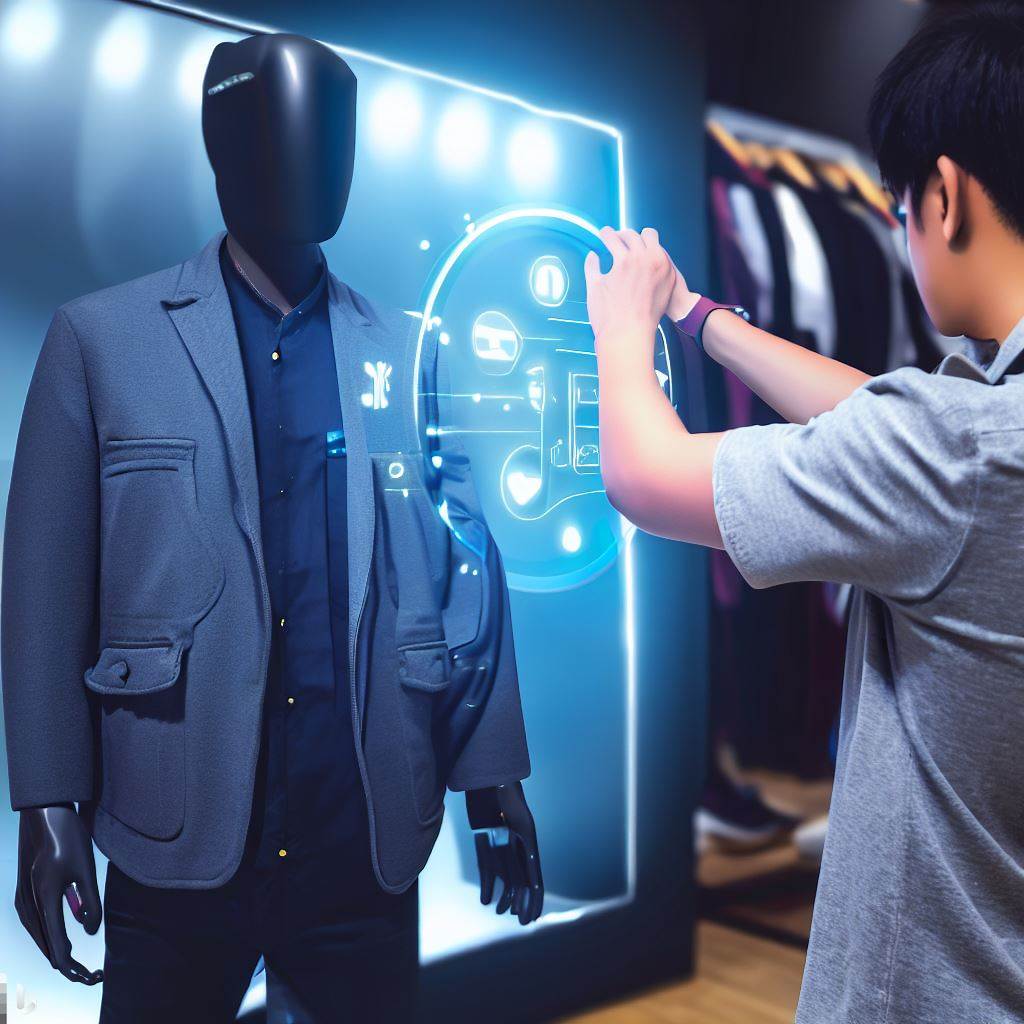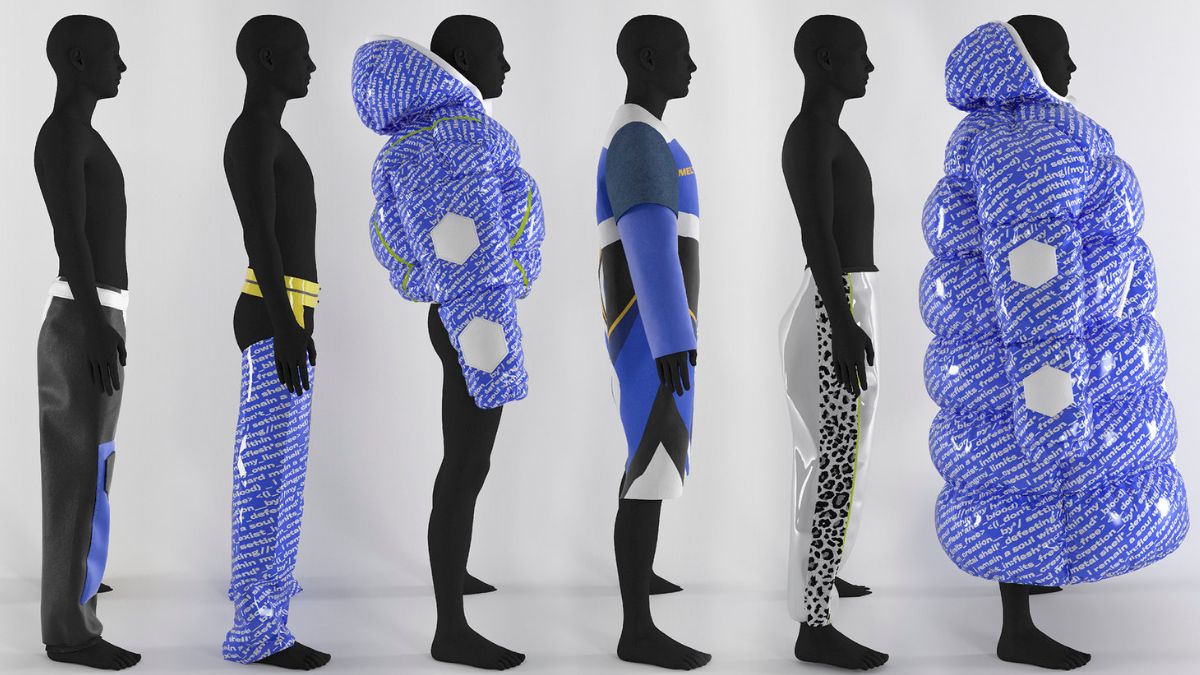How AI is changing the landscape of fashion and textile design is a transformative narrative. From AI-powered design tools revolutionizing pattern creation and textile printing to the optimization of manufacturing processes and the personalization of the customer experience, artificial intelligence is reshaping the industry at an unprecedented pace. This exploration delves into the multifaceted impact of AI, examining its applications across design, production, supply chain management, and ethical considerations, painting a vivid picture of the future of fashion.
We’ll investigate how AI algorithms are generating unique textile designs, streamlining production, and even predicting consumer trends. We will also explore the ethical implications of this rapid technological advancement, considering potential job displacement and the responsible use of data. Ultimately, this analysis aims to provide a comprehensive understanding of AI’s role in the evolution of the fashion and textile industry.
AI-Powered Design Tools in Fashion

The fashion industry, traditionally reliant on human creativity and manual processes, is undergoing a significant transformation thanks to the integration of artificial intelligence. AI-powered tools are streamlining design workflows, accelerating production, and fostering innovation in ways previously unimaginable. This revolution is impacting every stage of the fashion lifecycle, from initial concept to final product.AI algorithms are rapidly changing the way designers approach pattern creation and garment construction.
These tools analyze vast datasets of existing designs, identifying trends and suggesting optimal patterns based on specified parameters like fabric type, body shape, and desired aesthetic. This significantly reduces the time and effort required for manual pattern making, allowing designers to explore more creative options and iterate faster.
AI-Driven Pattern and Print Generation
AI algorithms are not only revolutionizing pattern creation but also the generation of unique textile prints and patterns. Sophisticated software can analyze existing designs, identify recurring motifs, and generate entirely new variations based on learned patterns. Designers can input specific parameters, such as color palettes, textures, or even s describing the desired aesthetic, and the AI will generate a range of unique print options.
This process dramatically expands the possibilities for textile design, allowing for the creation of highly personalized and intricate patterns that would be impossible to achieve through traditional methods.
| AI Design Tool | Capability | Example | Benefits |
|---|---|---|---|
| StyleGAN2-ADA | Generates high-resolution images of clothing and textiles with varied styles and patterns. | Can create realistic renderings of new clothing designs based on user-defined parameters, including color, texture, and style. | Rapid prototyping, exploration of diverse design options. |
| DeepFashion | Analyzes fashion images to identify trends, styles, and patterns. | Can be used to predict popular designs or to identify unique features in existing designs. | Trend forecasting, design inspiration. |
| Textile Design AI | Generates unique textile patterns based on user input, such as color palettes and textures. | Can create intricate and complex patterns that would be difficult or impossible to create manually. | Increased efficiency, expanded design possibilities. |
| Generative Adversarial Networks (GANs) | Creates novel designs by learning from a dataset of existing designs and generating new, realistic-looking variations. | Can generate unique prints and patterns, adapting to different styles and requirements. | Innovation, personalized design. |
AI in Virtual Prototyping and 3D Modeling, How AI is changing the landscape of fashion and textile design
AI is significantly impacting virtual prototyping and 3D modeling for clothing, leading to a reduction in the need for physical samples. Traditional methods involve creating multiple physical prototypes, which is a time-consuming and expensive process. AI-assisted methods, however, utilize 3D modeling software combined with AI algorithms to create realistic virtual prototypes based on design specifications. These virtual prototypes can be manipulated and tested virtually, allowing designers to identify and correct design flaws before physical production begins.
This reduces waste, speeds up the design process, and lowers overall costs.
| Process | Traditional Method | AI-Assisted Method |
|---|---|---|
| Prototyping | Manual pattern making, multiple physical samples, time-consuming and expensive. | 3D modeling software with AI-driven pattern generation and virtual fitting, rapid prototyping, cost-effective. |
| Fitting | Physical fitting on models, potential for errors and revisions. | Virtual fitting on 3D avatars, allows for adjustments based on body shape and size data. |
| Design Iteration | Slow and iterative process involving physical adjustments. | Rapid iteration and adjustments in the virtual environment. |
| Material Selection | Relies on experience and physical testing of materials. | AI can analyze material properties and predict performance, optimizing material selection. |
AI’s Influence on Textile Production

The textile industry, a cornerstone of global manufacturing, is undergoing a significant transformation driven by artificial intelligence. AI’s capabilities are being harnessed to optimize every stage of textile production, from raw material selection to the final product, leading to increased efficiency, reduced waste, and improved quality. This section will explore the specific applications of AI across various stages of textile manufacturing and compare these new methods with traditional approaches.AI is revolutionizing textile production by providing data-driven insights and automating complex processes.
This allows manufacturers to improve resource allocation, predict potential issues, and ultimately, create a more sustainable and efficient production line. The integration of AI is not simply an incremental improvement; it represents a paradigm shift in how textiles are conceived, manufactured, and delivered to the market.
AI in Material Selection
AI algorithms can analyze vast datasets of material properties, including fiber type, strength, durability, and cost, to optimize material selection for specific textile applications. This involves predicting the performance characteristics of different materials under various conditions, allowing manufacturers to choose the most suitable option for a given product. For example, an AI system could analyze the properties of various cotton blends to determine which blend will best meet the requirements for a specific type of shirt, considering factors like breathability, drape, and durability.
This leads to reduced material waste and improved product quality.
AI in Dyeing Processes
The dyeing process is a significant source of water pollution and energy consumption in textile manufacturing. AI-powered systems can optimize dyeing parameters, such as temperature, time, and chemical usage, leading to significant reductions in both environmental impact and production costs. Specific AI applications include:
- Predictive modeling to optimize dye recipes and reduce water and energy consumption.
- Real-time monitoring of dyeing processes to ensure consistent color and quality.
- Automated control systems to adjust dyeing parameters based on real-time data.
For instance, AI can predict the optimal dye concentration needed to achieve a specific shade, minimizing dye waste and reducing the environmental footprint of the process. This is a significant step towards more sustainable textile production.
AI in Weaving and Knitting
AI is also transforming the weaving and knitting processes. AI-powered systems can optimize the weaving patterns, predict potential defects, and improve the efficiency of the machinery. This leads to reduced production time, improved fabric quality, and reduced material waste. Specific examples include:
- Predictive maintenance of weaving and knitting machines to minimize downtime.
- Automated quality control systems to identify and reject defective fabrics.
- AI-driven design tools to create innovative and complex weaving and knitting patterns.
By predicting potential machine failures and optimizing production parameters, AI can significantly increase the uptime and efficiency of weaving and knitting machines, resulting in cost savings and increased production capacity.
Comparison of Traditional and AI-Integrated Textile Production
Traditional textile production relies heavily on manual processes and experience-based decision-making. While this approach has been successful for centuries, it often lacks the precision and efficiency of AI-integrated methods. AI-integrated methods offer several advantages: improved efficiency, reduced waste, enhanced quality control, and increased sustainability. However, the initial investment in AI systems can be substantial, and there may be a learning curve associated with implementing and managing these systems.
Furthermore, concerns around data security and job displacement need to be addressed. The table below summarizes the key differences:
| Feature | Traditional Methods | AI-Integrated Methods |
|---|---|---|
| Efficiency | Lower | Higher |
| Waste | Higher | Lower |
| Quality Control | Manual, less precise | Automated, more precise |
| Sustainability | Lower | Higher |
| Cost | Lower initial investment, higher operational costs | Higher initial investment, lower operational costs (long-term) |
AI and Personalized Fashion Experiences
The integration of artificial intelligence (AI) is revolutionizing the fashion industry, moving beyond automated design and production to create deeply personalized experiences for consumers. This shift is driven by the increasing availability of customer data and the sophistication of AI algorithms capable of analyzing and interpreting this information to predict trends, tailor recommendations, and even create custom garments. This personalization promises to enhance customer satisfaction, increase brand loyalty, and optimize the overall efficiency of the fashion supply chain.AI’s capacity to analyze vast datasets allows for the creation of highly accurate predictive models of fashion trends and individual preferences.
This goes beyond simple demographic analysis; AI can identify subtle patterns and correlations in purchasing behavior, social media activity, and even environmental factors to forecast future demand with greater precision than traditional methods. This predictive power enables brands to optimize inventory management, reduce waste, and respond more effectively to evolving consumer desires.
AI-Driven Trend Prediction and Preference Analysis
A system utilizing AI for trend prediction and preference analysis would incorporate several key components. First, it would collect and integrate data from diverse sources, including customer purchase history, website browsing behavior, social media interactions (likes, shares, comments on fashion-related content), and even weather patterns (influencing seasonal clothing choices). This data would then be fed into sophisticated machine learning algorithms, such as neural networks or deep learning models, trained to identify patterns and predict future trends.
For instance, an AI system might analyze past sales data to predict the popularity of specific colors or styles in upcoming seasons, or it might identify emerging trends by analyzing social media posts and identifying s and hashtags associated with particular fashion items. The output of this system would be actionable insights for designers and merchandisers, enabling them to create collections that align more closely with consumer demand.
This predictive capability would significantly reduce the risk of overstocking unpopular items and improve the overall profitability of fashion businesses. Examples of companies already utilizing this approach include Stitch Fix, which uses algorithms to curate personalized clothing recommendations for its subscribers, and ASOS, which employs AI to personalize product recommendations on its website.
AI-Powered Personalized Shopping Experiences
AI is transforming the shopping experience by providing highly personalized recommendations and interactive virtual try-on capabilities. AI-powered recommendation engines analyze customer data to suggest products that align with individual preferences and past purchases. This surpasses traditional recommendation systems by considering a wider range of factors, including style, size, price point, and even the customer’s emotional state inferred from their online behavior.
Furthermore, AI-powered virtual try-on technology allows customers to visualize how clothing items would look on them without physically trying them on. This is achieved through advanced image processing and computer vision techniques that overlay digital representations of clothing onto images or videos of the customer. This technology reduces the need for returns and enhances the overall shopping experience by allowing customers to make more informed purchasing decisions.
Companies like ModiFace are pioneers in this space, providing virtual try-on solutions for numerous fashion brands.
AI-Facilitated Custom Clothing Creation
AI-powered platforms are emerging that enable the creation of customized clothing items based on individual body measurements and preferences. These platforms utilize 3D body scanning technology and AI algorithms to generate precise digital avatars of customers. These avatars can then be used to design and create custom-fit garments. The customer can specify design elements such as fabric type, color, style, and embellishments.
The AI system then generates a digital pattern and manufacturing instructions, allowing for the efficient and precise production of the customized garment. This approach minimizes waste, reduces production time, and delivers a truly unique and personalized product to the customer. While this technology is still relatively nascent, companies are actively developing and refining these AI-powered platforms, paving the way for a future where mass customization is the norm rather than the exception.
For example, companies like CustomMade are already offering custom-made clothing, although they may not yet fully leverage AI to the extent described.
AI in Fashion Supply Chain Management

The fashion industry, notorious for its complex and often unpredictable supply chains, is ripe for disruption through the application of artificial intelligence. AI offers the potential to streamline operations, reduce waste, and improve responsiveness to fluctuating consumer demand, ultimately boosting profitability and sustainability. By leveraging AI-powered tools, fashion brands can gain unprecedented visibility and control over their entire supply chain, from raw material sourcing to final product delivery.AI’s role in optimizing fashion supply chains extends across various stages, significantly impacting inventory management, logistics, and overall efficiency.
The implementation of AI solutions, however, requires careful planning and consideration of the unique challenges inherent in the fashion industry’s dynamic nature.
AI-Driven Inventory Management and Demand Forecasting
Accurate inventory management and demand forecasting are crucial for minimizing stockouts and overstocking, both of which can severely impact profitability. AI algorithms, particularly machine learning models, can analyze vast datasets encompassing historical sales data, seasonal trends, social media sentiment, and even weather patterns to predict future demand for specific garments with greater accuracy than traditional methods. For example, a retailer might use an AI system to predict the demand for a particular summer dress based on past sales data, current weather forecasts, and the popularity of similar styles on social media platforms.
This allows for optimized production planning and prevents overproduction of slow-moving items or shortages of high-demand products. Such systems can also analyze real-time sales data to dynamically adjust inventory levels, ensuring optimal stock across the supply chain.
AI-Enhanced Logistics and Distribution
AI is revolutionizing logistics and distribution in the fashion industry by optimizing transportation routes, warehouse management, and last-mile delivery. AI-powered route optimization software can analyze traffic patterns, delivery times, and other factors to determine the most efficient delivery routes, reducing transportation costs and delivery times. Similarly, AI-driven warehouse management systems can automate tasks such as inventory tracking, order fulfillment, and warehouse layout optimization, improving efficiency and reducing labor costs.
Imagine a scenario where an AI system automatically directs warehouse robots to pick and pack orders based on real-time demand, minimizing human intervention and maximizing speed and accuracy. Furthermore, AI can enhance last-mile delivery through improved route planning and the utilization of autonomous delivery vehicles, providing a more efficient and potentially cost-effective solution.
Challenges and Solutions in AI Integration
Integrating AI into existing fashion supply chains presents several challenges. Data integration and quality are significant hurdles, as AI algorithms require large, clean, and consistent datasets to function effectively. Many fashion companies struggle with data silos and inconsistent data formats, hindering the effective implementation of AI solutions. Another challenge lies in the need for significant upfront investment in AI infrastructure and expertise.
Implementing AI solutions requires investment in software, hardware, and skilled personnel to develop, deploy, and maintain these systems. Finally, the dynamic nature of fashion trends and consumer preferences necessitates adaptable AI systems capable of learning and adjusting to rapidly changing conditions.Addressing these challenges requires a phased approach. Companies should begin by identifying specific areas where AI can deliver the most significant impact, focusing on data quality improvement and establishing clear goals and metrics for success.
Collaboration with AI specialists and technology providers is crucial, as is the development of robust data governance frameworks to ensure data accuracy and consistency. Investing in employee training and upskilling is also essential to ensure that the workforce has the necessary skills to effectively utilize and manage AI-powered tools. By addressing these challenges proactively, fashion companies can successfully integrate AI into their supply chains and reap the substantial benefits it offers.
Ethical Considerations and the Future of AI in Fashion: How AI Is Changing The Landscape Of Fashion And Textile Design
The integration of artificial intelligence into the fashion industry promises significant advancements, but it also raises crucial ethical questions that must be addressed proactively. The potential for job displacement, algorithmic bias, and data privacy violations necessitates a careful and considered approach to ensure AI’s responsible implementation. Failing to do so could lead to significant social and economic consequences.The transformative potential of AI in fashion is undeniable, but its impact on employment requires careful consideration.
Automation of tasks like design, pattern-making, and production could lead to significant job losses, particularly for roles involving repetitive or manual labor. However, this disruption also presents an opportunity for upskilling and reskilling initiatives. The fashion industry could invest in training programs that equip workers with the skills needed to manage and interact with AI systems, creating new roles in areas like AI training, data analysis, and AI-system maintenance.
Furthermore, the increased efficiency brought about by AI could lead to the creation of new, higher-skilled jobs focused on creative direction, strategic planning, and customer experience management. A proactive approach focusing on workforce adaptation and retraining is vital to mitigate the negative impact of job displacement.
Job Displacement and Mitigation Strategies
AI’s automation capabilities could displace workers in various segments of the fashion industry. For example, automated pattern-cutting machines could reduce the need for skilled pattern makers, while AI-powered design tools might lessen the demand for junior designers. To mitigate this, proactive retraining and upskilling programs are crucial. These programs could focus on teaching employees how to operate and maintain AI systems, analyze data generated by AI tools, and manage the creative process in collaboration with AI.
Moreover, investing in education and training that fosters critical thinking and problem-solving skills will help workers adapt to the changing landscape and remain competitive in the evolving job market. Companies could also consider offering incentives for employees to participate in such programs, ensuring a smooth transition and minimizing the impact of job displacement. The success of this mitigation strategy relies heavily on collaboration between industry stakeholders, educational institutions, and government agencies.
Data Privacy and Algorithmic Bias
The use of AI in fashion relies heavily on vast amounts of data, including consumer preferences, purchasing history, and even body measurements. This raises significant concerns about data privacy and the potential for misuse of sensitive information. Robust data protection measures are essential to ensure that consumer data is handled responsibly and ethically. This includes implementing strong encryption protocols, obtaining informed consent for data collection, and providing users with transparency regarding how their data is being used.
Moreover, the algorithms driving AI-powered fashion systems are susceptible to bias, potentially leading to discriminatory outcomes. For example, an AI system trained on biased data might disproportionately recommend certain styles or products to specific demographic groups. Mitigating this requires careful attention to data curation, algorithm design, and ongoing monitoring for bias. Regular audits and independent evaluations of AI systems can help identify and address potential biases before they lead to unfair or discriminatory outcomes.
Transparency in the development and deployment of AI algorithms is also crucial to build trust and accountability.
A Future Fashion Industry Powered by AI
Imagine a future where AI seamlessly integrates into every aspect of the fashion industry. Designers collaborate with AI tools to create innovative and sustainable collections, using predictive analytics to anticipate future trends and minimize waste. Personalized virtual fitting rooms allow customers to try on clothes virtually, reducing returns and promoting sustainability. AI-powered supply chains optimize production processes, ensuring efficient resource allocation and minimizing environmental impact.
However, this future also presents potential downsides. The over-reliance on AI could stifle creativity and lead to a homogenization of styles. The potential for job displacement remains a concern, and the ethical challenges surrounding data privacy and algorithmic bias must be continuously addressed. The success of this AI-driven future hinges on a balanced approach that leverages AI’s capabilities while mitigating its potential risks, prioritizing ethical considerations and human well-being.
This future necessitates a proactive approach that balances technological advancement with social responsibility, ensuring that the benefits of AI are shared equitably and its potential harms are minimized. A scenario where AI assists human creativity rather than replacing it entirely would foster both innovation and job security.
Wrap-Up

The integration of AI into the fashion and textile industry is not merely a technological advancement; it’s a fundamental shift in how we design, produce, and consume clothing. While challenges remain, particularly concerning ethical considerations and job displacement, the potential benefits – increased efficiency, sustainability, and personalized experiences – are undeniable. The future of fashion is undeniably intertwined with AI, promising a dynamic and innovative landscape that will continue to evolve in exciting and unpredictable ways.
Understanding this evolution is crucial for navigating the changing tides of this transformative industry.

